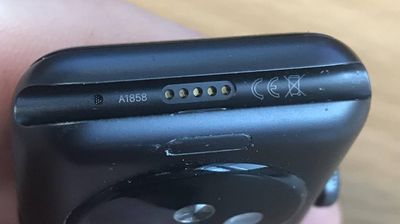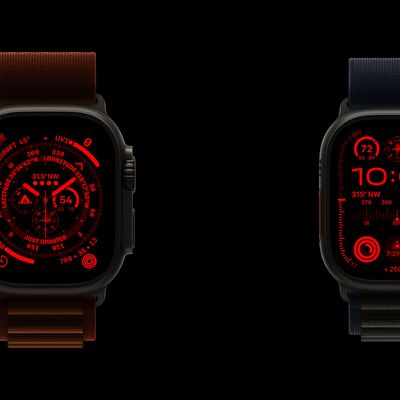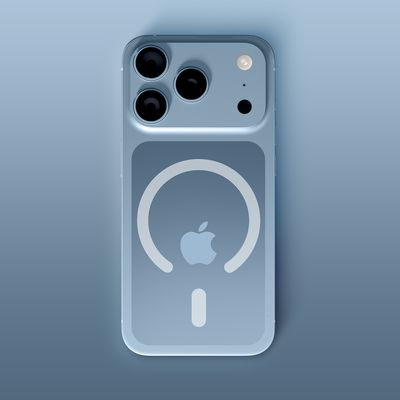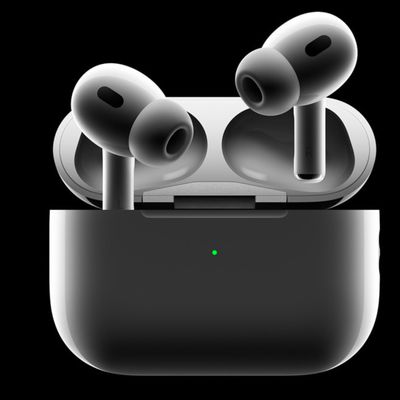Apple Watch Series 7 Lacks Hidden Diagnostic Port, Likely Uses Wireless Data Transfer Instead
Last month, FCC filings revealed that Apple Watch Series 7 models are equipped with a new module that enables 60.5GHz wireless data transfer. This module is not advertised on Apple's website and is likely for Apple's internal use only.

MacRumors has since confirmed with
The Verge's Dieter Bohn and others that the Apple Watch Series 7 lacks a hidden diagnostic port that was located in the bottom band slot on all previous Apple Watch models. Apple used the port for diagnostic purposes when servicing an Apple Watch, such as to restore watchOS over a wired connection with a special tool.
The lack of a diagnostic port on Apple Watch Series 7 models likely explains the addition of the 60.5GHz wireless data transfer module. FCC filings indicated that the module is only activated when the Apple Watch is placed on a proprietary magnetic dock with a corresponding 60.5GHz module, so it sounds like Apple might use this dock to perform diagnostics or restore watchOS wirelessly on Series 7 models.
It's also worth noting that Series 7 models feature IP6X-rated dust resistance, so perhaps the diagnostic port's removal helped with that to some degree.
Apple Watch Series 7 models will begin arriving to customers and launch in stores this Friday, October 15. Key features include larger displays with 41mm and 45mm case sizes, enhanced durability with IP6X-rated dust resistance, up to 33% faster charging with an included USB-C fast charging cable, and new aluminum colors.
Popular Stories
The long wait for an Apple Watch Ultra 3 appears to be nearly over, and it is rumored to feature both satellite connectivity and 5G support.
Apple Watch Ultra's existing Night Mode
In his latest Power On newsletter, Bloomberg's Mark Gurman said that the Apple Watch Ultra 3 is on track to launch this year with "significant" new features, including satellite connectivity, which would let you...
The iPhone 17 Pro Max will feature the biggest ever battery in an iPhone, according to the Weibo leaker known as "Instant Digital."
In a new post, the leaker listed the battery capacities of the iPhone 11 Pro Max through to the iPhone 16 Pro Max, and added that the iPhone 17 Pro Max will feature a battery capacity of 5,000mAh:
iPhone 11 Pro Max: 3,969mAh
iPhone 12 Pro Max: 3,687mAh...
Apple's next-generation iPhone 17 Pro and iPhone 17 Pro Max are just over two months away, and there are plenty of rumors about the devices.
Below, we recap key changes rumored for the iPhone 17 Pro models.
Latest Rumors
These rumors surfaced in June and July:Apple logo repositioned: Apple's logo may have a lower position on the back of the iPhone 17 Pro models, compared to previous...
The upcoming iPhone 17 Pro and iPhone 17 Pro Max are rumored to have a slightly different MagSafe magnet layout compared to existing iPhone models, and a leaked photo has offered a closer look at the supposed new design.
The leaker Majin Bu today shared a photo of alleged MagSafe magnet arrays for third-party iPhone 17 Pro cases. On existing iPhone models with MagSafe, the magnets form a...
Apple's position as the dominant force in the global true wireless stereo (TWS) earbud market is expected to continue through 2025, according to Counterpoint Research.
The forecast outlines a 3% year-over-year increase in global TWS unit shipments for 2025, signaling a transition from rapid growth to a more mature phase for the category. While Apple is set to remain the leading brand by...
iOS 26 and iPadOS 26 add a smaller yet useful Wi-Fi feature to iPhones and iPads.
As spotted by Creative Strategies analyst Max Weinbach, sign-in details for captive Wi-Fi networks are now synced across iPhones and iPads running iOS 26 and iPadOS 26. For example, while Weinbach was staying at a Hilton hotel, his iPhone prompted him to fill in Wi-Fi details from his iPad that was already...
Apple today seeded the second betas of upcoming iOS 18.6 and iPadOS 18.6 updates to public beta testers, with the betas coming just a day after Apple provided the betas to developers. Apple has also released a second beta of macOS Sequoia 15.6.
Testers who have signed up for beta updates through Apple's beta site can download iOS 18.6 and iPadOS 18.6 from the Settings app on a compatible...




















